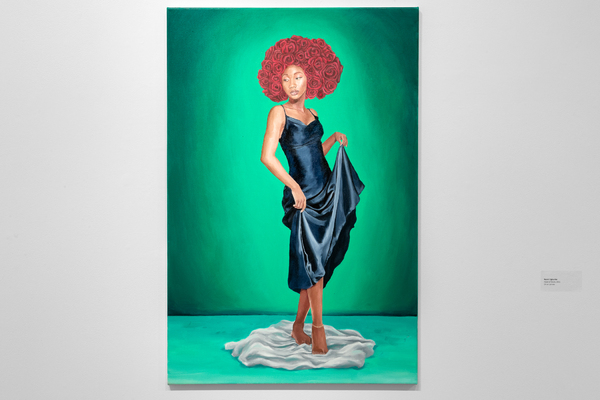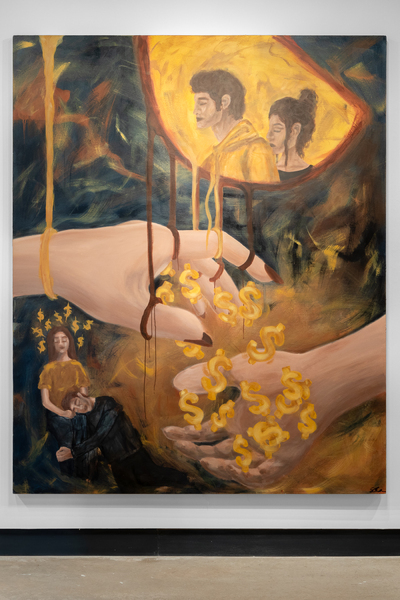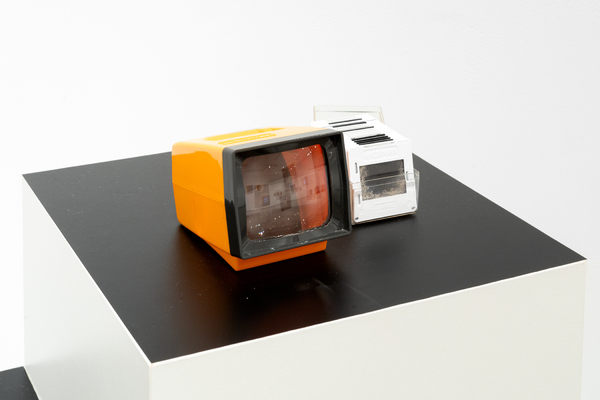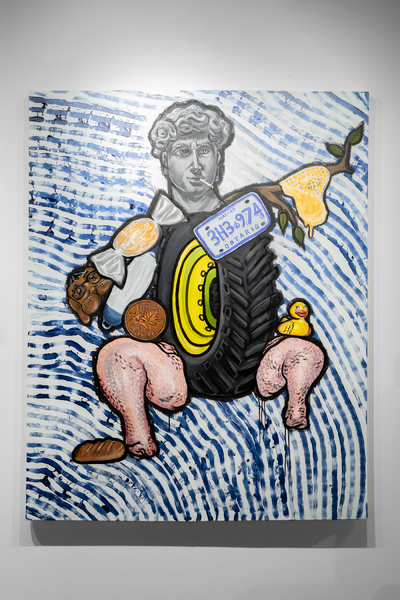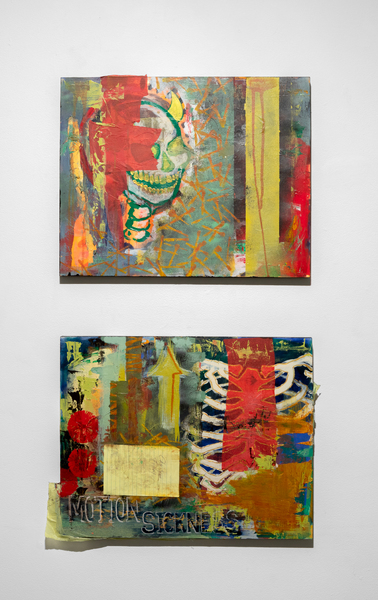Artist Statements
RABIA CHOUDHARY
Through the female figure, language, and cultural and religious iconography, I explore the multifaceted experiences of my life in my work. I investigate the relationship between different identities and how these intersections sometimes clash (ethnicity, religious faith, sexuality, etc.). My work depicts experiences and struggles with tenderness, love, growth, and reclamation regarding conflicting identities. Each piece examines aspects of one or more of these identities by depicting objects, clothing, jewellery, patterns, figures and/or language directly from my childhood and life. My inspiration comes from aspects of my Pakistani culture, such as Mehndi art, Salwar Kameez, Churiyan, and Bindi and traditional Islamic geometric patterns found in Masjids and Islamic art. In addition, I engage with phrases and words from Urdu, which is my mother tongue and one that I would like to reconnect with through my art practice. I incorporate my language in terms of titles, pieces, and words and poems within the backgrounds or patterns. Specific phrases and words derived from Arabic hold religious significance and reference Islamic practices that I grew up with. These works contain many hidden letters, words, and phrases, especially within the handmade paper works. I chose to create one paper for each family member, with words, phrases, and memories that remind me of them and our shared growth. In making these pages, I can deconstruct and then reconstruct my memories and my shame to create something more beautiful and delicate—something to be gentle with. The soft-touch needed to develop these pages is one I wish I had given myself in my youth. This series emerges from a need to reclaim my being, struggles, and experiences. Although the figures within my artwork intend to represent my being, the figures also represent all of us, in this very space. The memories I have used to create these artworks are ones I wish to share with you. It is in our nature to struggle with identity and who we are in a world that defines what is socially acceptable and determines who has value. Through this work, I hope you find strength, connection, worth, tenderness, vulnerability, and the growth needed as you navigate your own tender pain and memories.
NAOMI EGBUNIKE
I was born and raised in Nigeria, which is a very culturally rich and diverse place, and most of my works tend to include my culture in some form, whether intentional or not. I am particularly interested in creating depictions of Black women that focus on their beauty and their struggles, both historically and in the present. These images resonate with my personal experience and that of other women. This body of work expands on my series Nature and the Black Woman, which combines the beauty of nature with the beauty of the Black woman. In the drawings created for this exhibition, I wanted to portray aspects of elegance, innocence, and vulnerability, as these are emotions and concepts that are not often shown in depictions of Black women. These images intertwine elements of nature. As a child, I would constantly hear Black women compared to the earth and to nature; comparisons such as “brown skin like rich soil,” “hair like trees growing up toward the sun,” and “tall like an Iroko tree.” I continue to be fascinated by these comparisons, and this project revolves around all the possible ways I can blur the line between Black women, Nigerian culture, and nature—both conceptually and literally—to create a mesmerizing whole. Trees are like the mother of nature, and they are dominant in my visual representations. They are vital to the creation and sustenance of ecosystems, and we can measure the state of our environment by how healthy or sick our trees are. I see these same qualities of resilience and power in the Black women that surround me. I also integrate ideas of growth and death in my work. Everything that blossoms will also die, including trees, flora and fauna, and human beings. Nothing can escape death. As I merge these elements of nature with the body of the Black woman, I integrate the idea of limited time and an end of growth through the dead trees that appear in some pieces and blooming flora in others. I also include animal elements as a way to add further power to the Black women in my work and honour their presence. I have always been extremely interested in surrealism, especially the combining of two seemingly mundane features to create a fantastical landscape or beings, and this plays an essential part in how I bring these various elements together in my drawing practice. My art is fundamentally a merging of fantastical imagery with traditional Nigerian art and culture. The artistic combination of culture, nature and the body present in my work can also be seen in ancient African murals and art pieces.
SARAH FORMOSA
My current work revolves around notions of the human condition and connections between people. I am drawn to painting female portraits and figures while experimenting with texture and colour. I am interested in exploring important discussions on awareness and mindfulness—of ourselves and others—and how everyone’s lives are just as complicated as my own, if not more. The Reliance series reflects a traumatic past relationship with a man who heavily relied on me, both financially and emotionally. He drained my financial resources through continual manipulation, and as he owed me more and more money, I became trapped and unable to leave the relationship until he paid me back. I knew that if I left him, I would never see that money again. So I stayed, but the money never materialized. The original goal of the Reliance series was to expose this person for all of the terrible things he has done. The series began with anger. But through the painting process, I came to realize that the works are actually about allowing myself to become vulnerable to my audience. The series exposes me and what I let happen. It is about the lessons that I have learned and the promise I have made to never let this happen again. The paintings express specific aspects of what I have gone through. Dead Weight and Expensive Lessons speak to how heavy his problems felt during the relationship. The painting Exhaustion focuses on how I was continually being affected, even after the relationship had ended. However, the painting process had a lot to do with the healing process. It forced me to face certain troubling thoughts and emotions so that I could heal. Dedicating months to this process led me to realize that I should be prioritizing my own happiness more than someone else’s needs. That is why I created my final painting, Broken All Ties, to represent the immaculate feeling of being free from him. As personal as this series is to me, I’d like these paintings to speak more broadly about the importance of putting yourself first, and not letting anyone take advantage of your kindness. I hope that, by being vulnerable about this part of my life, I might be able to help someone else, so that they don’t need to pay the same heavy price.
JULIE LUTH
Central to my art practice is the idea of legacy and personal archives, which I explore by referencing imagery from my collection of thrifted photographs and film. In the past, I have explored the idea of memory and identity through more traditional mediums, such as drawing and painting, but I have since broadened my art practice to include analogue photography and other alternative photographic practices. My body of work, Infecting the Everyday, includes two central artworks made using clips and stills from three rolls of 8mm film shot by a family in the 1970s. The identity of this family and the context of their footage has been lost. Yet, the physical film remains and holds the moments of their everyday lives that they wanted to preserve in a tangible way. This includes clips of a child pushing a lawnmower, a man jumping off a small ledge, and a group of people waiting for the bus. Devoid of context, these small moments become representations of our own intimate experiences. Before You Touch This Wash Your Hands, is a singular 8mm film reel hand spliced together and presented using an antique 8mm film editor that I have restored. The screen of the viewer is framed by pieces of dirt and debris, so that as the footage plays the audience is confronted by both beauty and impurity. The second artwork, Nothing Can Kill 100% of Germs, is a set of homemade glass slides that can be viewed using an individual slide viewer. To create the slides, I printed stills from the films in the darkroom but disrupted their chemical processing by applying developer using a spray bottle and a small hand sanitizer dispenser. I created 35mm film positives of these images and sandwiched them between layers of watercolour, hair, dust, and fingernail clippings. I chose to present images from the 8mm films in both a moving and still format based on the following quote from the article Unfolding the In-between Image written by Masaki Kondo: “The objects depicted in the still image exist in the past but they cannot exist in the present as they did at the moment of capture. The objects that emerge in the moving image maintain their existence only in the duration of its virtual continuity...” Although we can temporarily access these past moments, we will never be able to experience them fully in the present. In reflecting upon this reality, I considered the dramatic shift in all our daily lives since the beginning of the pandemic. Our previous routines have been disrupted by necessary health precautions and the fear of contamination. Even as rates of infection begin to drop, we cannot return to our previous experiences of the everyday because our perceptions of normalcy have been fundamentally changed. When we consider our past and look to our future, we may mourn the fragments of our lives that no longer feel safe but were once mundane. Through Infecting the Everyday, I encourage the viewer to consider the coexistence of grief and beauty within the compositions I have created using domestic images from the past. As we reimagine our lives post- pandemic, I hope to remind the audience to take time to savour the small moments within our everyday lives that feel mundane. Once they have passed, we can never relive them, so it is important to recognize the beauty of these moments in the present and to treat our everyday lives as precious enough to archive in a physical way
KIMBERLEY ROGERS
My mixed media practice explores concepts of nostalgia, memory, and self through mediums such as acrylic paints, oil pastels, charcoal, and found or thrifted materials. My current body of work aims to challenge and subvert the body types depicted in classical Western sculpture, which portray how the “ideal” man or woman should look and act. While these works were created hundreds of years ago, we still experience the pressures and effects of these idealisms today. My paintings and mixed media works incorporate images of classical Western sculpture imagery to reimagine what these sculptures might look like if they reflected how we look and act in a contemporary context. They include depictions of objects tied to specific memories and stories of people I have encountered throughout my life; each object represents a specific memory or story. Some are comical and lighthearted, relating to happy memories, and some are quite sad and dark, relating to more traumatic events from my life. Along with my paintings, I have created zines that explain the individual components of my paintings. I like to think of this body of work as one that bridges the world of art history with modern day contemporary art through the form of abstraction. Each of these works represents different figures in my life: men are the focus of Maybe it runs in the family ; women and motherly figures in Because she said so; and My quarter life crisis is a self-portrait. I began this series by creating a digital collage that contained all of the imagery I wanted to use. I then drew a rough outline of this onto the canvas using charcoal sticks, and sprayed fixative to set the charcoal. Next, one by one, I painted each object onto the canvas. Each of these individual images is like a miniature painting in itself, and combined, they tell the story of my life.
CHARELLE ST-AUBIN
This body of work continues my ongoing investigation of my childhood memories, which I first began exploring as a way for me to mentally escape the difficult reality of the COVID-19 pandemic. After completing a series of drawings exploring nostalgia through found objects collected in my youth, I started creating work about my grandmothers. I have two grandmas— one on my mother’s side of the family, who is still alive and well, and another on my father’s side, who passed away when I was eight years old. My desire to hold onto my memories of my grandmothers fuels my current artistic interests. This series attempts to encapsulate memories of my grandmothers through sculptures, photographic processes, and textile-based artworks. In particular, I am interested in forming new connections with my grandmothers with sculptures that use (or are inspired by) traditional feminine crafts and gendered household chores that my grandmas would have performed, such as cooking, cleaning, sewing, embroidery, knitting, and quilt-making. Bon Appétit, Love Mom references the cooking and baking my paternal grandma loved to do. I used cyanotypes (a type of photographic process) to create copies of her recipes and reupholstered the cushions of kitchen chairs with the fabric prints. These almost unreadable recipes were originally written on scraps of paper and are full of grammatical errors, grease marks, and love. While my grandma may be gone, her memory is still being passed down and shared through family meals. In A Place to Share Memories, I made a print block on a table surface and carved shapes into it that reminded me of my maternal grandma and our adventures collecting found objects. I am sharing these memories by providing printing supplies for visitors so that they can create a print or rubbing from the table to take with them. My work is inspired by early feminist artists such as Judy Chicago, Miriam Schapiro, Mierle Laderman Ukeles, and Faith Wilding. Many early feminist artists used traditional women’s crafts, which are not traditionally considered “high art,” to challenge the male-dominated art world. Like these feminist artists, I use domestic practices, such as sewing and baking, to create my sculptures. By learning and using these traditional skills my grandmothers would have performed, I am documenting the memories I have of them while forming new connections with my matrilineal lineage.
CHERILYNN TILLEY
My art practice evolves as I continue to grow as an artist. For my series Evacuation, I worked from a place of emotion and focused on expressing my feelings. The body of work is ongoing and has been a form of therapy. The inspiration for Evacuation came from my struggle to overcome traumatic experiences in my life surrounding themes such as toxic relationships, broken family ties, love and loss, and betrayal. I chose to use my art practice to work through these issues that took a toll on my mental health. This series represents my struggle with interpersonal relationships. The layered paintings often start with a foundation of dark, moody colours thrown onto the canvas and blended. Next, I incorporate imagery and text, which I later work over and cover up as I go. This process of layering is evident in Mask and Motion Sickness. The imagery I choose to include in these works represents the loss I have felt from the lack of boundaries in my relationships. I paint a rib cage because it shows that there is simply nothing left to give, and all that is left are the sad remnants of what once was. The eyeball is a more obvious metaphor for being surveyed and constantly feeling on edge, as if never able to relax or take a break. Lastly, the traffic light with all red lights is imagery I chose to use to discuss a lack of control. The traffic light has all red lights as a way for me to take back my autonomy and say no; it represents standing up and doing what one needs to do for oneself. The longer you look at the pieces, the more you find the process of dealing with any trauma is complex. As this series evolves, I continue to draw inspiration from abstract expressionism, neo-expressionism, street art, and figuration libre. Artists within these styles tend to express emotion in a way that I find extremely powerful, which is an essential part of my practice.

